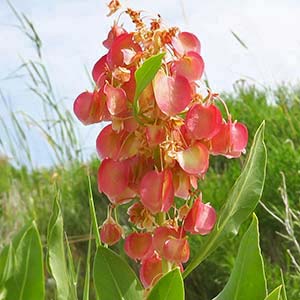Rumex venosus
Rumex tomentellus
rumex veine, vein dock, veiny dock, wild-begonia, wing dock
willow creek dock
ascending or, rarely, erect, usually producing axillary shoots near base, (10–)15–30(–40) cm.
erect, branched in distal 1/2–2/3, 30–70(–100) cm.
blades ovate-elliptic, obovate-elliptic, or ovate-lanceolate, (2–)4–12(–15) × 1–5(–6) cm, subcoriaceous, base narrowly to broadly cuneate, margins entire, flat or slightly undulate, apex acute or acuminate.
ocrea deciduous or partially persistent at maturity;
blade oblong-lanceolate, 20–30 × 5–10 cm, base cordate to broadly cuneate, margins entire, repand, flat or crisped, apex acute or attenuate.
terminal and axillary, usually occupying distal 2/3 of stem/shoot, usually dense, or interrupted in proximal part, broadly paniculate.
terminal, occupying distal 1/2–2/3 of stem, interrupted in proximal 1/2, paniculate, branched.
articulated near middle, filiform or slightly thickened, (8–)10–16 mm, articulation distinct, slightly swollen.
articulated in proximal 1/3, filiform, distinctly swollen in distal part (near base of tepals, but not at articulation point), 4–14 mm, articulation weakly evident, not swollen.
5–15 in whorls;
inner tepals distinctly double-reticulately veined, orbiculate or reniform-orbiculate, 13–18(–20) × (20–)23–30 mm, base deeply emarginate or cordate, margins entire, apex rounded, obtuse, rarely subacute, with short, broadly triangular tip;
tubercles absent, occasionally very small.
10–20 in whorls;
inner tepals oblong-ovate, 4–6 × 3–5 mm, base rounded to subcordate, margins entire, apex obtuse or subacute;
tubercles absent.
brown or dark brown, 5–7 × 4–6 mm.
mature specimens not seen.
= 40.
= 120.
Rumex venosus
Rumex tomentellus
Rumex venosus is a distinctive species rarely confused with any other members of the genus. However, I have seen herbarium specimens of it misidentified as R. hymenosepalus, and vice versa.
(Discussion copyrighted by Flora of North America; reprinted with permission.)
Rumex tomentellus is known only from New Mexico and needs additional study. It may represent one of the southern North American elements of the R. aquaticus–R. occidentalis aggregate.
(Discussion copyrighted by Flora of North America; reprinted with permission.)
- Local floras:
CA,
OR,
WA
- Local Web sites:
CalFlora,
CalPhotos,
Flora NW,
KS Wildflowers,
MN Wildflowers,
PNW Herbaria,
Turner Photog.
WildflowerSearch
iNaturalist (observations)
USDA Plants Database
- LBJ Wildflower Center
- SEINet
- Plants of the World Online
- Encyclopedia of Life
- Wikipedia
- Google Image Search


